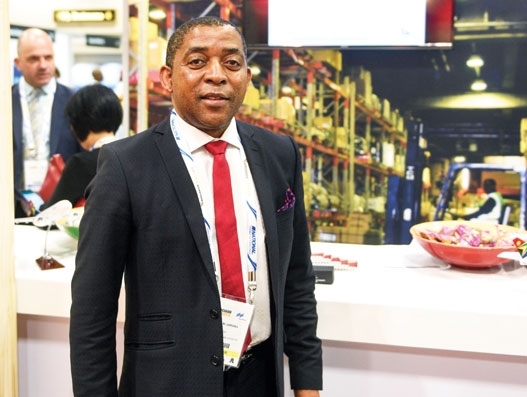
FROM MAGAZINE: Right-sizing SAA’s portfolio can bring it into books of profit
South African Airways (SAA) has been on a restructuring mission for over a year. With time still left to complete the three-year break-even period as committed to the country’s government for transforming the airline, SAA Group CEO Vuyani Jarana shares different countours of the work in progress with Shalini Nair at Air Cargo Africa 2019 […]

South African Airways (SAA) has been on a restructuring mission for over a year. With time still left to complete the three-year break-even period as committed to the country’s government for transforming the airline, SAA Group CEO Vuyani Jarana shares different countours of the work in progress with Shalini Nair at Air Cargo Africa 2019 in Johannesburg. Assigned with a complex task of saving a terminally ill company since November 2017, Jarana ensures the best repositioning of the flag carrier to the South African government who wants SAA to be privatised. Hailing from a telecommunication background, Jarana believes in fixing the 1934-founded airline with the latest technology and modern digital tools. Edited excerpts.
What framework have you put in place to amend the commercial side of SAA’s operation?
As SAA has been undergoing a tough time for a few years, our biggest challenge is how to address the market. Our cost base being very high, we need to find the right cost structure to give us headroom to compete. Thus, the priority is how we trade commercially on profitable routes, procuring things at the best market price, bringing in a lot more data science on the revenue management side and transforming the organisation to be a lot more agile.
We are dividing SAA into three business units - regional, domestic and international. Hence, each of these units will focus on delivering results in their own territory pushing in better trade and profit & loss (P&L) accountability. To achieve this, we have to identify skills within SAA and promote them to make sure that they can focus on flying for profits. Those are the key big-ticket items that form the part of our strategy.
With the lack of support from your government, what strategy has been adopted by you to implement the three-year break-even period committed to revamping the airline?
We have completed our first year of delivering and just a couple of years left to fulfill this commitment. Certain projects due to their level of complexity are getting delayed. Our strategy involves building a very strong team to reduce these complexities, right-sizing the organisation, bringing skills on commercial delivery and configuring the business to be fit for the future.
We want to be a player of substance and scale in the continent. Through franchisee agreements, we will work with our partners in East and West Africa. We want to improve our network capability into regions, where we are underrepresented today by working with partners by sharing the same aspirations on security and safety.
How have you set the bailout path for SAA within three years?
There is a combination of things to look at it like as debt and equity position and balance sheet restructuring. Obviously, negative equity in the balance sheet will call for capital from the shareholders. However, everything doesn’t happen at a go. Convincing shareholders that what can actually evolve and reduce the debt exposure of SAA at an acceptable level is more vital. But the shareholder has his own decision on when and how to capitalise SAA. As management, our job is to shape the P&L and make proposal around balance sheet structure for the right decision to be made.
Moving out from a digital background, how are you envisaging digital disruption in SAA’s development?
Internet of things (IoT) plays a crucial role on the technical side. Different original equipment manufacturers (OEMs) supplying engines and aircraft to us collect a lot of data around engine performance. This data forms a maintenance schedule. At SAA, we are trying to build this capability to have more insights on the operation side for getting predictive maintenance.
On the commercial front, if we understand customer insights and what do they prefer in their customer journey, we will be able to provide specific offers to them. Today, normal open pricing platform is replaced by private pricing; people insist on paying for the value of the product being brought. We are making ourselves capable of working on the insights of customer preferences and putting a competitive value proposition into the market.
How are you exploring trade opportunities with Asia?
Recently, the president of South Africa was in India to promote trade. We have to find ways through which we can leverage this opportunity and support the same. This is a shift in the economic and trade relations to East, whereas traditionally it was always to the West.
Policy instruments like SAATM and AfCFTA have been framed for Africa’s development, how do you see the potential of African air cargo industry?
The African Continental Free Trade Agreement (AfCFTA) agreement, once endorsed by all countries, will create the single largest free trade zone (FTZ) by geography creating opportunities for intra-African trade. At the same time, we need to have the air cargo capability to connect the continent. Single African Air Transport Market (SAATM) can connect the continent seamlessly but that alone is not enough. As the policies are developed by the state, we need to find solutions that are pragmatic, technology-based, including the possibilities for industrialising electric cargo manifest, customs clearance, improved customer experience, and operating at the lowest cost.
Can you detail the interline agreement between SAA and Africa World Airlines (AWA).
As AWA operates regional jets in West Africa, it will help us deliver e-commerce cargo on-time to towns and regions, where road or rail was only an option. This relationship will give us a competitive advantage in West Africa in terms of cargo delivery.

